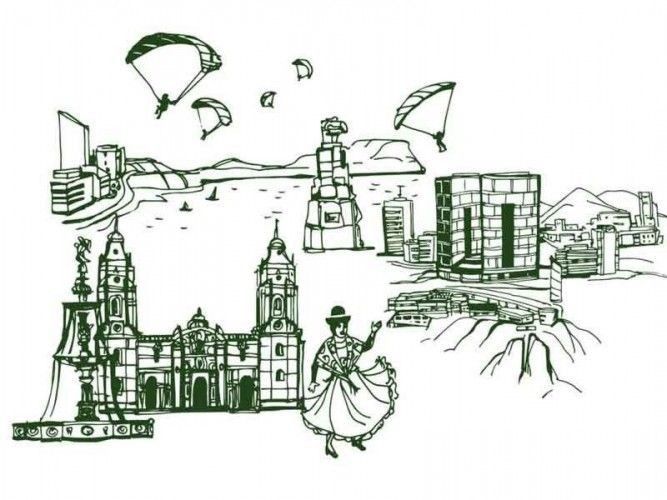Lima today is no longer the wealthy, beautiful colonial settlement and most important city in the Americas like it used to be during colonial times; or the lovely capital of independent Peru with nice haciendas, fishing villages and lots of green surrounding it. Today Lima, with its over 9 million inhabitants, shantytowns and sometimes tatty facades, isn't attractive or seems to be inviting to its visitors.
Introduction
Arriving at the Lima International Airport with crowds of people offering taxi and hotel services and finally the ride to your hotel through Lima's chaotic traffic can be quite shocking or even scary, especially for those who heard good meant warnings about general safety and security in Peru's capital.
But Lima's first appearance to its visitors is deceptive. Lima is one of the most interesting and challenging cities in South America with a huge archaeological, historical, and cultural past. Most of its treasures might be well hidden, but are worth being discovered. For many visitors, Lima is just an unavoidable must; a sprawling, chaotic, dirty and ugly metropolis, the starting and ending point on their trip to more interesting and exciting gems Peru offers. But this assumption doesn't do justice to Lima.
Lima's decline
From the middle of the 20th century onwards, Lima had to cope with serious problems. Political and economic instability in Peru increased the overall poverty. Thousands of migrants from the Peruvian countryside came to the capital looking for work and a better life, building their homes in ever-growing slums that soon surrounded the city. Lima hit rock bottom in the early 1990s when even more people, fleeing the terror and poverty in the Andean highlands and jungle, flocked into Lima, just to find more terror, chaos and poverty. There was nothing positive to say about Lima.
But after many years of deterioration, Lima recovered with the beginning of the new millennium. Many years of hard work, from the municipality and its inhabitants, have turned some 'barrios' (shantytowns) into more or less pleasant districts, others stayed unbelievably poor without proper infrastructure. Here the city tried at least to improve living conditions, built hospitals, new schools and sporting areas. By far not enough, but at least a beginning.
Lima's recovery
Since 1995 the Municipality of Lima has been implementing a successful recovery plan for the historic center of Lima, which was declared a 'Cultural Patrimony of Humanity' by the UNESCO in 1996. The Municipality of Lima 'cleaned' the city center in an effort to remove many of the persistent street vendors (unfortunately there is still quite a lot left) and dodgy figures. Programmes started by the government encouraged the citizens to be proud of their city, renovate buildings and 'shape up' streets and parks to recuperate the city's cultural heritage and of course to promote tourism. Also other major works in Lima's historical center like new illumination, remodelling of parks and plazas, the repaving of sidewalks with terra cotta, the planting of thousands of trees, more police presence on the streets and daily maintenance paid off. The city center is much safer and nicer to look at.
Around town, especially in the wealthier suburbs like Miraflores, San Isidro and Barranco, but also in lower middle-class areas, you can see changes every day. The district municipalities are eager to improve their districts, but unfortunately a lot of old houses are demolished and skyscrapers built on their place. Streets are repaved, parks and green areas are carefully looked after and finally the security for Limeños and tourists is improved with special police forces. As well, a good beginning is made, but there is still a lot to do...
Lima's slow, but steady improvements to becoming a tourist destination itself
Many small steps have been made to stop Lima's deterioration and organize the chaos. There is much more to do, especially in the extremely poor outskirts. And authorities and inhabitants are willing and able to do so. Today Lima, with its hardly to cope with enormous population, about one-third of Peru's inhabitants of which around 50% live in poverty, is the seat of the Peruvian government and houses most of Peru's industry. Lima dominates the political, commercial and cultural life of the country and accommodates Peruvians and foreigners from different social and cultural backgrounds. Therefore Lima today has an amazing cosmopolitan atmosphere. The historic city center and districts among others like Miraflores, the City Center, Barranco and San Isidro have excellent cafes, bars and restaurants, which offer amazing Peruvian cuisine for fair prices and a nowhere else to find special charm for nothing. Huge shopping malls and fashionable shops let you forget that you actually are in a developing country. Many outstanding smaller and bigger museums, amazing ancient and historic buildings next to modern structures and the friendly and open "Limeños" introduce you perfectly to the rich history and culture the city and the country offers.
Seeing Lima just as gateway into Peru and rushing through this amazing city you might miss a vital part of what is Peru today. Lima is worth to be seen as a destination for itself. Take your time to acclimatize yourself, look behind the sometimes chaotic, dirty, unpleasant and ugly exterior and discover the highlights the metropolis Lima offers. You might be pleasantly surprised.
Hopefully this page, dedicated only to the amazing and crazy capital of Peru helps you to find your way through the city jungle and to discover the one or other hidden treasure.








































































